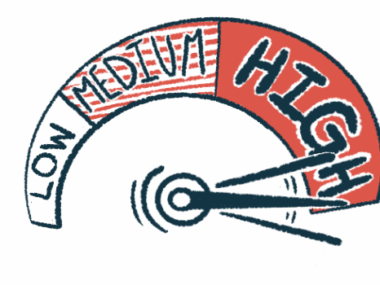ARRS assessment predicts kidney failure in Scottish AAV patients
Test may offer more outcome data than standard clinical, biochemical measures
Written by |

The ANCA Renal Risk Score (ARRS) — based on kidney biopsy and lab results — could accurately predict kidney failure in a large group of Scottish people with ANCA-associated vasculitis (AAV), a study shows.
The test better discriminates the risk of kidney failure in AAV and may offer clinicians more outcome data than standard clinical and biochemical measures alone, according to the researchers.
“This is the first time the ARRS has been validated in a national [group of patients],” the researchers wrote in “Outcomes in ANCA-Associated Vasculitis in Scotland: Validation of the Renal Risk Score in a Complete National Cohort,” which was published in Kidney International Reports.
In AAV, self-reactive antibodies called anti-neutrophil cytoplasmic autoantibodies (ANCAs) trigger immune neutrophil cells to be overly active, causing inflammation and damage to small blood vessels. Glomeruli, the kidney’s filtration units, contain tiny blood vessels that can become inflamed in AAV, affecting normal kidney function and potentially leading to kidney failure.
A kidney biopsy is a standard method to confirm an AAV diagnosis and monitor disease activity or progression. It involves collecting and examining a small piece of kidney tissue under a microscope for signs of damage to glomeruli or surrounding tissue.
ARRS scores to assess AAV kidney failure
The ARRS has been suggested as a reliable method to predict kidney failure, also called end-stage kidney disease (ESKD), in AAV. It relies on both biopsy results and biochemical data from blood work to classify patients as high, medium, or low risk for developing kidney failure.
“The ability to accurately predict kidney outcomes would enable a more personalized therapeutic approach,” wrote researchers in the U.K. who sought to validate the ARRS using data from a large group of Scottish patients whose AAV was confirmed by kidney biopsy within the Scottish Renal Biopsy registry.
Of the 288 AAV patients (51.7% male) in the study, 180 were diagnosed with microscopic polyangiitis and 108 with granulomatosis polyangiitis, the two main types of AAV. Their mean age at biopsy was 66.9 and most (63.2%) were positive for ANCAs against the MPO enzyme. The remaining 36.8% had ANCAs against the PR3 enzyme. MPO and PR3 are the most common antibody targets in AAV.
Participants were followed for a mean of three years, during which 39 (13.5%) relapsed, 39 (13.5%) progressed to kidney failure, and 67 (23.2%) died. Relapse occurred after a median of 2.6 years, kidney failure after a median of three years, and death after about three years.
ARRS score and risk
ARRS scores were calculated based on three criteria — the percentage of normal glomeruli; the estimated glomerular filtration rate (eGFR), a measure of kidney function; and the percentage of scar tissue or kidney tubular shrinkage. Scores between 8-11 points represent a high risk of kidney failure, 2-7 points medium risk, and 0 points low risk.
Based on ARRS scores, 144 patients (50%) were classified as having low risk of kidney failure, 132 (45.8%) with medium risk, and 12 (4.2%) with high risk.
Compared with the other risk groups, the high-risk group had a significantly lower median eGFR and higher urinary protein-to-creatinine ratio (uPCR), both signs of kidney disease. Bleeding into the lungs and testing positive for anti-PR3 ANCAs were significantly more common in the high-risk group, who were also significantly more likely to undergo plasma exchange and/or blood dialysis at presentation.
A relapse was less common with increasing ARRS scores, with no relapses in the high-risk group, 9% in the medium group, and 18.4% in A the low-risk group.
Using a statistical model adjusted for age, sex, AAV type, uPCR, and eGFR, lower eGFR and higher uPCR values were significantly associated with progression to ESKD. With the addition of ARRS to the model, medium and high ARRS scores were significantly linked to progression to kidney failure.
The medium-risk ARRS category was associated with a nearly fourfold higher risk for ESKD progression and patients in the high-risk group had an about 13 times higher ESKD risk. The ARRS category was not related to increased risk of relapse or death, however.
“ARRS showed better discrimination for ESKD than either eGFR or uPCR alone,” the researchers wrote.
How risk changed with treatment, deprivation
Predictive power for kidney failure risk increased even further by adding the type of AAV treatment to the model. Treatments included plasma exchange, dialysis at presentation, cyclophosphamide, and rituximab, sold as Rituxan in the U.S. and MabThera in Europe, with available biosimilars.
In this model, patients with medium-risk ARRS scores had a four times higher ESKD risk and those in the high-risk category had a 16 times elevated risk of kidney failure.
No changes in predictive power were observed when the model accounted for socioeconomic deprivation, which is prevalent in Scotland and is recognized as a contributing factor to disease outcomes. A deprivation assessment included income, employment, education, health, access to services, crime, and housing.
These findings highlighted that “the simple ARRS, calculated using routinely collected clinical and [disease-related] data, can predict progression to ESKD in those with AAV proven at biopsy,” the researchers wrote. “That the ARRS has now been validated in a large, multicenter, national [group of patients] should allow clinicians to deploy it as a valuable prognostic tool in the management of AAV with kidney involvement.”





